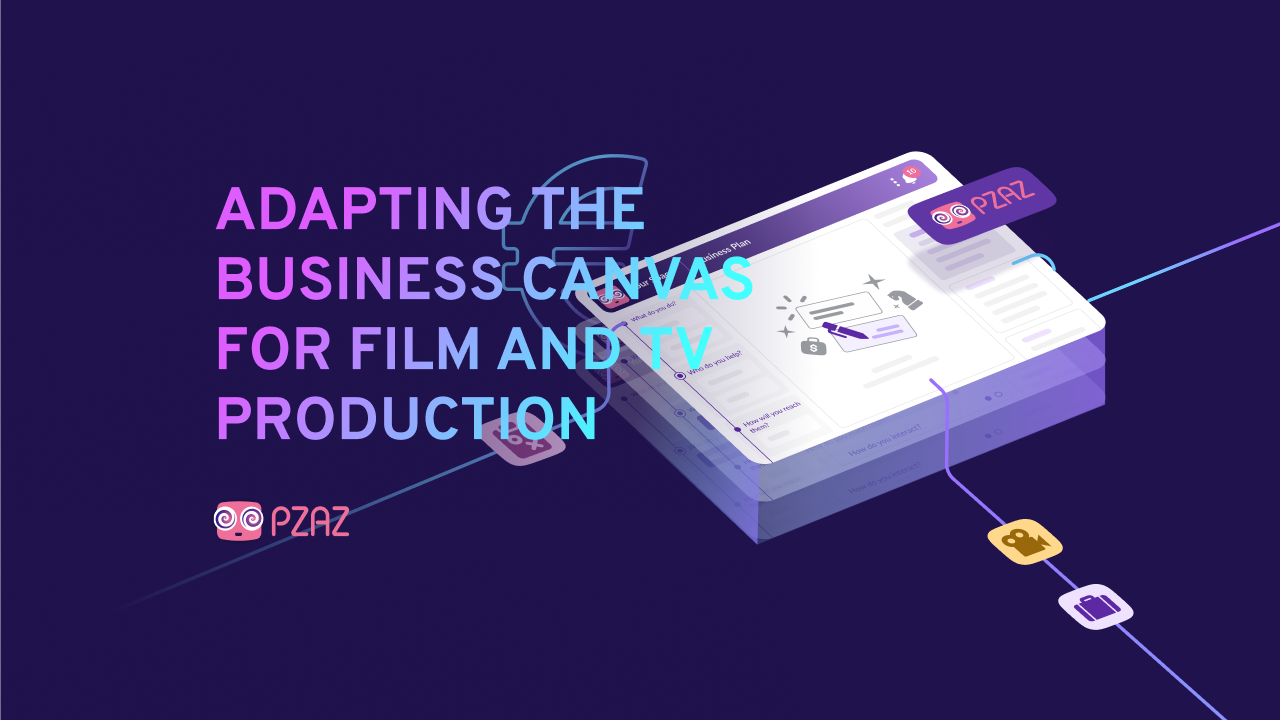Mastering the Business of Creativity: Adapting the Business Canvas Model for Film, TV, and Video Production

Bridging the Gap: Why Creative Professionals Need a New Business Blueprint.
In the ever-evolving landscape of filmmaking, TV production, and video creation, the pursuit of excellence and innovation remains at the forefront of every creator’s mind. Despite the abundance of talent and creativity within the industry, there exists a notable gap in the form of accessible, comprehensive guides that cater specifically to the unique needs and challenges faced by professionals in this field. This void not only hampers the ability of creators to streamline their processes but also makes it challenging to navigate the complexities of the industry’s business aspects.
Recognising this gap, our latest article aims to bridge this divide by providing a foundational understanding of the Canvas Business Model, tailored to resonate with filmmakers, TV producers, and video creators. While it may appear that the principles of a business model are distant from the creative nuances of the film and television industry, the reality is quite the contrary. The essence of creating compelling narratives and engaging content is inherently intertwined with understanding and applying the core aspects of a successful business strategy.
With its intricate production processes, diverse customer segments, and the constant need for innovation and differentiation, the film industry benefits immensely from a structured approach to business planning. Similarly, TV producers and video creators, navigating the competitive landscape of content creation, can leverage these insights to carve out their niche, optimise their operations, and achieve sustainable growth.
This article, while generic in nature, serves as a crucial stepping stone for industry professionals. It demystifies the fundamental components of a business model, from defining a unique value proposition to identifying key resources, activities, and partnerships. By understanding these principles, you will be better equipped to apply them in a manner that aligns with the specific demands and opportunities of the film, TV, and video creation industry.
Furthermore, this article sets the stage for a series of dedicated pieces that delve deeper into creating business plans specifically designed for film, TV, and video script and production. These subsequent articles will build upon the foundational knowledge provided here, offering more detailed guidance and tailored strategies that cater to the industry’s nuances.
In essence, our aim is to empower filmmakers, TV producers, and video creators with the tools and knowledge necessary to not only excel in their craft but also to navigate the business landscape of the industry with confidence and strategic acumen. So, we invite you to embark on this journey with us, starting with the universal principles outlined in this article, and continuing onto the more specialised insights to come. Together, let’s unlock the full potential of your creative and business endeavours.
Following this introduction, the article delves into the specifics of adapting the Business Model Canvas for the creative industry, offering a comprehensive guide that includes:
- What do you do?
- Who do you help?
- How will you reach them?
- How do you interact?
- What do you need?
- How do you do it?
- Who will help you?
- What will it cost?
- How much will you make?
By breaking down the Canvas Business Model into these key areas, the article provides a structured approach to business planning that is specifically tailored to the needs of those in the film, TV, and video production industries.
Exploring the Depths: A Comprehensive Guide to the Business Model Canvas
Delving deeper into the Canvas Business Model, we uncover a robust framework designed not only to navigate the intricate maze of establishing a thriving enterprise but also to meticulously structure creative projects from conception to realisation in the world of film, TV, and video production. This comprehensive guide extends beyond the surface, offering a granular examination of each facet of your business model—from articulating a compelling value proposition to mapping out effective revenue streams, and incorporating essential tips and illustrative examples for each chapter. As we embark on this in-depth journey through the model, we ensure that each step is marked with clarity and strategic acumen, providing a blend of practical advice and inspiration that is as crucial to the creative process as it is to business planning.
What do you do?
Your Value Proposition and Your Strategy
Embarking on the creative journey requires a clear understanding of your mission or ‘why.’ Articulating this might be challenging, yet it’s fundamental to defining the essence of your project within the film, TV, or video landscape. This foundational step not only delineates the purpose behind your creative venture but also highlights how your work offers solutions to existing gaps or challenges in storytelling or audience engagement. Identifying this allows you to craft a value proposition that succinctly answers, “What do you do?” and sets a direction for selecting an appropriate strategy.
Red Ocean vs Blue Ocean Strategy
What market conditions do you operate in?
In the realm of content creation, choosing between Red Ocean and Blue Ocean strategies is pivotal. These strategies illuminate whether you’re entering a competitive, saturated market or pioneering a niche with untapped potential.
Blue Ocean represents uncontested market space.
Opting for a Blue Ocean strategy means venturing into less explored territories, where the focus is on innovation and creating demand in a space with minimal competition. This approach often leads to rapid growth and profitability due to the lack of direct competition and the freedom to set your own pricing strategies.
Example: Cirque du Soleil revolutionised the circus industry by blending art, theatre, and acrobatics, thus crafting a new genre of entertainment and tapping into an uncontested market space.
This implies:
- Venturing into new, uncontested market spaces.
- Focusing on innovation to create and nurture new demand.
- Minimal relevance of competition.
- Freedom in pricing strategies.
- High potential for profit and growth.
Red Ocean represents an existing market.
A Red Ocean strategy means diving into a market brimming with competitors. Here, success often hinges on differentiation and capturing market share from established players.
Example: A new streaming service entering the crowded market must offer unique content or innovative features not provided by existing platforms to attract and retain subscribers.
This entails:
- Navigating a competitive, crowded market.
- Striving for differentiation to capture attention and market share.
- Competitive pricing strategies are influenced by the market.
- The challenge of standing out in a sea of competitors.
Consider these five trigger questions to determine your market strategy:
- Are you pioneering an untapped niche or entering a competitive arena?
- Is your focus on creating new demand or capturing a share of the existing market?
- How do you view competition: as a challenge to differentiate or as a limited concern?
- Do you have the flexibility to set your own pricing, or will competitors influence it?
- What is the profit and growth potential in your chosen path?
Adapting these considerations to the context of filmmaking, TV production, and video creation ensures that your creative endeavours are not just artistically fulfilling but also strategically positioned for success in the competitive landscape of the entertainment industry.
What makes you different?
Your Value Proposition
In the creative industries of film, TV, and video production, your value proposition is the unique narrative or visual experience you offer to your audience. It’s the compelling reason why viewers should choose your work over others. Whether you’re introducing groundbreaking storytelling techniques, exploring underrepresented themes, or leveraging the latest technology to enhance viewer immersion, your value proposition stands as a beacon of innovation in a sea of content.
To fine-tune your value proposition, consider these tailored questions:
- What unique stories, perspectives, or experiences does your project bring to the screen?
- Who are the early enthusiasts of your work, and why do they gravitate towards it?
- What gaps or desires in content consumption does your project fulfil for its audience?
- In what ways does your project enrich the viewer’s experience or provoke thought?
- How does your project differentiate itself from similar works regarding content, execution, or engagement?
Addressing these questions can help clarify the distinct value your film, TV show, or video content offers. It allows you to articulate not just the essence of what you create but also the impact it has on its audience, distinguishing your work in a competitive landscape and laying the groundwork for meaningful connections with your viewers.
Who do you help?
Your Customer Segment and Your Users
In the context of film, TV, and video production, understanding your audience is paramount. This section will guide you in identifying not just who your content aims to entertain or inform but also who will directly interact with and benefit from your creative work. By the end, you’ll have a clearer picture of:
- Your primary audience (Customer Segment).
- The viewers or users engaging with your content (Users).
- Those most likely to embrace your innovative projects from the outset (Early Adopters).
Who is your target audience?
Customer Segment
In the creative industries, your audience isn’t just a group of consumers; they are the heart of your projects’ existence. Whether you’re creating for the mass market or catering to niche interests, understanding your audience’s preferences, habits, and loyalty is crucial. This knowledge not only influences your storytelling approach but also guides your marketing strategies and distribution choices, ensuring your content reaches and resonates with the intended viewers.
Examples:
- Mass Market: A streaming service providing various genres to cater to diverse tastes.
- Niche Market: A production company specialising in documentaries on environmental conservation, targeting eco-conscious viewers.
- Segmented: A channel offering different programming blocks for children, teens, and adults, each tailored to the specific interests of these age groups.
- Diversified: A platform that offers not only entertainment content but also educational tutorials, serving varied user needs.
- Multi-sided: A production house that creates content for television networks and online streaming platforms, addressing the demands of different viewer bases.
Questions to Consider:
- Who will find the most value in your content?
- What unique needs does your content fulfil for its audience?
- How does your content stand out to potential early adopters within your target audience?
Who else will use your offering?
Users
In the realm of filmmaking and content production, users extend beyond traditional viewers. They include anyone who interacts with your content, be it through direct consumption, participation in interactive elements, or community engagement around your work. Focusing on users allows you to broaden your perspective on how your content delivers value, encouraging a more user-centric approach to content creation.
Questions to Guide Identification:
- Who engages with your content, and in what ways?
- How does your content impact its users, and what feedback do they provide?
- Who champions your content, sharing it with wider audiences?
Who will take a risk with your offering?
Early Adopters
Identifying early adopters is especially crucial in creative fields, where innovation and fresh concepts are constantly sought after. These are the trendsetters and enthusiasts eager to explore new narratives, styles, and formats. Catering to early adopters can significantly amplify your project’s initial impact and help build momentum for wider acceptance.
Considerations:
- Which viewers are most receptive to and excited by new content?
- Who are the influencers within your target audience likely to advocate for your work?
- What characteristics define those most willing to engage with your content from the start?
By aligning your creative projects with the needs and interests of your customer segments and users, and by engaging early adopters, you lay a solid foundation for your work’s success. This approach ensures that your content not only reaches its intended audience but also creates meaningful connections, fostering a loyal viewer base.
How will you reach them?
Your Marketing & Distribution Channels
In the realms of film, TV, and video production, successfully reaching your audience is a critical aspect of your project’s success. This segment helps you pinpoint the optimal channels for marketing your creations and ensuring they are accessible to your intended viewers. By understanding these components, you’ll gain insights into effective promotional strategies (Marketing Channels) and discover the best ways to deliver your content to your audience (Distribution Channels).
How will you promote your offering?
Your Marketing Channels
For creatives in the film, TV, and video sectors, selecting the proper marketing channels is vital to spotlight your work and engage with your audience. Whether aiming to generate buzz for an upcoming release or to maintain interest in existing projects, the choice of marketing channels should reflect both the nature of your content and your audience’s preferences. Employ a strategic mix to highlight your project’s unique aspects.
- Community Building: Establish a dedicated fan base by fostering a community around your project, using platforms encouraging interaction and discussion.
- Content Marketing: Drive interest and anticipation through the creation and distribution of engaging content like teaser trailers, exclusive interviews, and behind-the-scenes looks.
- Customer Service: Enhance viewer loyalty by offering outstanding support, addressing inquiries, and simplifying access to your content.
- Email: Keep your project on your audience’s radar with newsletters that inform them of upcoming releases and exclusive content.
- Offline Ads: Utilize traditional advertising methods such as billboards and print ads to capture attention and establish a presence in the physical world.
- Offline Events (inc. Trade Shows): Participate in film festivals and industry trade shows to promote your brand and offering through in-person experiences.
- Online Ads (inc. SEM): Target your audience online through carefully crafted ad campaigns on social media and search engines tailored to highlight your project’s appeal.
- Online Events: Engage your audience through webcasts and webinars that offer immersive experiences similar to offline events but in a digital format.
- Partnerships: Forge connections with influencers, other creators, or brands to cross-promote content and tap into new audiences.
- Publicity (inc. Guerilla PR): Gain wider exposure by securing media coverage and employing unconventional marketing tactics to catch public interest.
- Sales: Directly engage potential viewers through promotional efforts designed to encourage early commitment.
- SEO: Optimize your online content for search engines to improve visibility and attract a larger audience organically.
- Viral Marketing: Encourage your audience to share your content, leveraging the power of word-of-mouth to expand your reach.
Consider these probing questions to refine your marketing approach:
- Who comprises your target audience, and where are they most active?
- Which channels have successfully reached similar audiences in the past?
- How can you uniquely engage with your audience to foster excitement and loyalty?
By carefully choosing and implementing the marketing and distribution channels best suited to your project and audience, you can ensure that your creative work not only reaches its intended viewers but also resonates deeply, encouraging engagement and building a strong, supportive community around your content.
How will you deliver to your customers?
Your Distribution Channels
For those in film, TV, and video production, determining the optimal paths to ensure your content reaches its audience is a vital aspect of your project’s success. Distribution channels are the conduits through which your creative work is delivered to viewers, encompassing everything from digital platforms to traditional broadcast methods. Selecting the right combination of channels is essential for effectively marketing your content. Understanding your audience’s preferences and viewing habits is key to choosing the most impactful distribution methods.
- Direct Channels: In the context of creative content, direct channels may include your own streaming platform or direct sales of digital downloads. These channels allow for greater control over the viewer experience and potentially higher profit margins, though they may require significant investment in technology and marketing to build audience reach.
Example: A film production company launches its own app, providing direct access to its films and exclusive content, thereby offering a personalised viewing experience to its audience. - Indirect Channels: Leveraging third-party platforms like streaming services, television networks, or online marketplaces can dramatically extend your content’s reach. While you may have less control over the distribution process and lower margins due to platform fees, the trade-off is access to established audiences and reduced distribution costs.
Example: Partnering with a streaming service to host your latest documentary series, tapping into the platform’s extensive subscriber base and distribution network.
Consider these questions to refine your distribution strategy:
- What are the preferred viewing platforms and habits of your target audience?
- Through which channels have similar content types found success in reaching their audience?
- How can you integrate multiple channels to provide a cohesive viewing experience?
- Which channels have proven most effective and efficient in terms of cost and reach for your specific type of content?
Understanding and strategically selecting your distribution channels ensures that your films, TV shows, or video content are accessible to the widest possible audience. This not only maximises your project’s visibility but also enhances your ability to engage with viewers across different platforms, contributing to the overall success of your creative endeavours.
How do you interact?
Your Customer Relationships
In the film, TV, and video production industry, fostering meaningful relationships with your audience is crucial for building loyalty and ensuring the longevity of your projects. Understanding the diverse ways you can interact with viewers, from personalised engagement to leveraging technology for automated communication, can significantly enhance the viewer experience. Here, we outline six types of interactions tailored to the creative industry, each designed to deepen your connection with your audience.
- One-to-One: This direct form of interaction is invaluable for gathering feedback on your work, addressing specific viewer inquiries, or offering exclusive insights into your creative process. For instance, hosting live Q&A sessions with key creative personnel can provide fans with a deeply personal connection to your work.
- Personalised: Tailoring communication to address the individual preferences and interests of your audience can significantly increase engagement. For example, offering personalised viewing recommendations based on previous viewing habits can make your platform more engaging.
- Community: Building a community around your project or brand allows for a shared space where fans can discuss, speculate, and offer feedback. Creating official forums or social media groups dedicated to your projects encourages a sense of belonging and community among viewers.
- Co-Creation: Inviting your audience to contribute ideas for future projects or content enhancements can foster a powerful sense of ownership and loyalty. Consider open calls for fan art, story ideas, or character designs that might be featured in your work.
- Self-Service: Providing comprehensive FAQs, how-to guides, or troubleshooting resources enables viewers to quickly find information or resolve issues, enhancing their overall experience with your content. An accessible, well-organized online resource centre can serve this purpose effectively.
- Automated: Utilizing technology to deliver personalised content updates, reminders for upcoming releases, or interactive experiences based on user preferences can streamline communication while keeping your audience engaged. Implementing chatbots for instant interaction on social media platforms or your website can offer real-time engagement without the need for constant human oversight.
As you consider these interaction types, reflect on the following questions to ensure your strategies align with audience expectations and industry standards:
- Which interaction methods will resonate most with your specific audience?
- How can you integrate these interactions throughout the viewer lifecycle to maximise engagement and satisfaction?
- What existing strategies have been successful, and how can they be improved or expanded?
- How can you balance cost-effectiveness with the quality of customer interactions?
- In what ways can these interactions be woven into the broader narrative of your brand or project?
By thoughtfully implementing a mix of these interaction strategies, you can create a dynamic and responsive relationship with your audience, enhancing their connection to your content and paving the way for sustained success in the competitive landscape of film, TV, and video production.
What do you need?
Your Key Resources
For those in the film, TV, and video production industry, key resources are essential for turning creative visions into reality and achieving market success. Whether these resources are owned, leased, or acquired through partnerships, they significantly influence your project’s development, launch, and growth.
Physical Resources: Tangible assets like high-quality cameras, editing software, sound equipment, and studio spaces are indispensable in the production process. For example, a production company might invest in state-of-the-art drones for aerial shots, enhancing the visual dynamism of a documentary or feature film.
Financial Resources: Budgeting for everything from set design to marketing is crucial. A film project can secure funding through a mix of grants, crowdfunding, and investment, similar to how independent filmmakers kickstart their projects. This financial backing supports various business activities, ensuring the project’s completion and distribution.
Intellectual Resources: Original scripts, copyrights, and trademarks form the bedrock of your project’s uniqueness. Consider a TV show that builds its brand around a patented filming technique or a unique narrative structure, making it instantly recognisable and legally protected.
Human Resources: The skills and talents of your crew, cast, and post-production team drive the quality of your project. An example here could be a film studio that prioritises diversity in its hiring practices, bringing a wide range of perspectives and skills to the creative process, akin to Pixar’s approach to assembling teams that bring stories to life.
Utilising Key Resources:
- Physical Resources: Leverage the latest technology to capture breathtaking visuals or streamline post-production workflows.
- Financial Resources: Allocate your budget to cover essential production costs, secure top talent, and fund innovative marketing strategies.
- Intellectual Resources: Use your unique concepts and protected content to distinguish your work in the marketplace and explore new storytelling avenues.
- Human Resources: Invest in professional development and foster a creative environment where talent can thrive and innovate.
Reflect on these aspects:
- How will each resource type contribute to the success of your project?
- What strategies will you employ to maximise the value of these resources?
- How can partnerships enhance your resource pool and project outcomes?
Incorporating these key resources thoughtfully into your production process ensures that your film, TV show, or video content is not only creatively ambitious but also commercially viable and resonant with audiences worldwide.
How do you do it?
Your Key Activities
In the film, TV, and video production sectors, key activities encompass the essential tasks and processes that bring creative concepts to fruition, ensuring they reach the audience effectively and sustain engagement. These activities, tailored to the unique dynamics of the entertainment industry, are critical for delivering compelling content, securing distribution channels, fostering viewer relationships, and driving revenue.
Production: At the heart of the industry, production involves everything from scriptwriting and casting to filming and editing. For instance, a production company might streamline its workflow by adopting digital shooting scripts and real-time editing software, similar to how high-profile productions manage their complex shooting schedules and post-production processes.
Problem Solving: Addressing creative challenges, logistical hurdles, and audience feedback is essential. A TV show might employ a team dedicated to analysing viewer data and feedback to adjust story arcs or character development in real time, mirroring the adaptive strategies used by successful streaming services.
Platform/Network Management: Leveraging digital platforms for content distribution and audience engagement is increasingly vital. A video creator could optimise their content for different social media platforms, using analytics to maximise reach and engagement, akin to how viral marketers tailor content to specific online communities.
Implementing Key Activities:
- Production: Emphasize efficiency and quality in your production processes, utilising the latest technology and techniques to enhance the storytelling and visual appeal of your projects.
- Problem Solving: Establish mechanisms for ongoing feedback and adaptation, ensuring your content remains relevant and resonant with your target audience.
- Platform/Network Management: Develop a strategic approach to content distribution, focusing on platforms that offer the best visibility and engagement opportunities for your target demographic.
Considerations for Key Activities:
- How will each activity contribute to the uniqueness and appeal of your offering?
- What strategies will you employ to ensure these activities are executed efficiently and effectively?
- How can collaboration with partners or the use of technology enhance the impact of these activities?
By prioritising these key activities, you position your film, TV show, or video project for success, ensuring that every step is optimised for impact, audience engagement, and commercial viability from the initial concept to the final release.
Who will help you?
Your Key Partners
In the realms of film, TV, and video creation, key partnerships can significantly influence the success of your projects. These strategic alliances, ranging from co-production agreements to distribution networks, are crucial for accessing additional resources, tapping into new markets, and enhancing the overall quality and reach of your productions. Understanding the role of each partner and the value they bring is essential for fostering relationships that contribute positively to your creative endeavours and business outcomes.
- Optimisation: Streamlining operations and reducing costs through partnerships can be transformative. For instance, a filmmaker might collaborate with a digital effects studio to access cutting-edge CGI technology, similar to partnerships seen in blockbuster productions that rely heavily on visual effects for storytelling.
- Mitigation: Collaborating with other entities can also serve as a risk management strategy, spreading the financial and operational risks associated with large-scale productions. Co-producing a series with another production company, sharing the burden of production costs and responsibilities, mirrors the approach used by studios to mitigate risks in high-budget projects.
Building Strategic Alliances:
- Consider partnerships with technology providers to access innovative tools that enhance production quality.
- Engage with streaming platforms early in the production process to secure distribution channels that align with your audience’s viewing habits.
- Collaborate with marketing agencies specialising in entertainment to amplify your project’s visibility and audience engagement.
Questions to Guide Partnership Decisions:
- Which partnerships are essential for accessing the resources and expertise needed for your project?
- How can suppliers and distributors play a role in enhancing the production and reach of your content?
- What strategic alliances can help mitigate the inherent risks of the entertainment industry?
- How do these partnerships align with and support your overall business strategy and creative vision?
By thoughtfully selecting and nurturing key partnerships, you position your film, TV show, or video content for greater success. These collaborations not only provide access to essential resources and expertise but also open up opportunities for innovation, risk-sharing, and reaching wider audiences, ultimately contributing to the growth and sustainability of your creative projects.
What will it cost?
Your Cost Structure + Your Fixed & Variable Costs
For creatives in the film, TV, and video production world, understanding your cost structure is fundamental to ensuring the financial viability of your projects. This knowledge enables you to navigate the financial aspects of production, from initial budgeting to final distribution, ensuring your creative endeavors are not just artistically successful but also financially sustainable. You’ll learn how to position your offering in the market, considering both the costs required to bring your project to fruition and the pricing strategy that aligns with your audience’s expectations and your financial goals.
What cost structure do you adhere to?
Your Cost Structure
Determining whether your production is cost-driven or value-driven influences every financial decision you make. A cost-driven structure prioritizes minimizing expenses to offer competitive pricing, while a value-driven approach focuses on delivering premium content that justifies higher price points.
- Value-driven: This approach is akin to producing a high-budget film or series that offers a unique viewing experience, such as exceptional special effects or A-list talent, justifying a premium subscription or ticket price.
- Cost-driven: Alternatively, a cost-driven strategy might be employed by independent filmmakers who leverage innovative, low-cost production techniques to produce compelling content on a tight budget.
Navigating Fixed and Variable Costs
Understanding the balance between fixed and variable costs is crucial. Fixed costs remain constant regardless of production scale, while variable costs fluctuate with the level of output.
- Variable Costs: For a film production, these might include location fees, costume rentals, and day rates for crew members, which vary depending on the length and complexity of the project.
- Fixed Costs: Fixed costs could encompass studio rental fees or the salaries of core team members engaged throughout the production cycle.
Strategic Financial Planning
By carefully analyzing these costs, you can make informed decisions about where to allocate your budget, identify potential savings, and optimize your production’s financial efficiency. Whether securing additional funding, negotiating better rates with suppliers, or deciding on the scale of your marketing campaign, each decision is informed by a clear understanding of your cost structure and its impact on your project’s overall financial health.
Consider these essential questions to guide your financial strategy:
- How does our choice of cost structure align with our creative goals and audience expectations?
- Which key resources and activities represent the largest share of our expenses?
- How can we optimize our spending to ensure the best possible return on investment?
- What financial strategies can we employ to enhance our project’s profitability and sustainability?
By diligently managing your cost structure and being mindful of both fixed and variable costs, you can navigate the financial challenges of the entertainment industry, ensuring your projects are not only creatively fulfilling but also financially successful.
How much will you make?
Your Revenue Streams
For those in the film, TV, and video production industries, diversifying revenue streams is key to financial sustainability and growth. This section delves into various revenue models that can be adapted to fit the unique demands of creative content production, enabling you to capitalize on your projects effectively. From one-time sales to recurring revenue, understanding and implementing these streams will bolster your project’s financial success.
- Asset Sale: This involves direct sales of content, such as selling a film to a distributor or offering DVDs and merchandise. Think of a successful indie film selling special edition copies online.
- Subscription Fee: A recurring revenue model seen in streaming services like Netflix, where your project is part of a library that attracts monthly subscribers seeking continuous access to quality content.
- Lending/Renting/Leasing: For equipment or studio spaces, this stream generates income by providing resources on a temporary basis. Production companies might rent out their studios or equipment during downtime.
- Usage Fee: Charging based on the consumption of content, similar to pay-per-view models for special broadcasts or exclusive online screenings of a film or series.
- Licensing: Offering the rights to use your content to other parties, such as TV networks or streaming platforms, for a fee. This could also include licensing merchandise or character rights for additional revenue.
- Brokerage: Acting as a mediator between entities, such as a production company facilitating deals between writers and networks, earning a commission from these agreements.
- Advertising: Generating income through sponsored content or ad placements within your videos or on your platforms. This is a common revenue stream for YouTube creators and ad-supported streaming services.
Strategic Considerations:
- Evaluate which revenue streams align best with your content and audience.
- Consider the long-term potential of each stream and its impact on your brand and creative control.
- Balance immediate revenue generation with strategies that build sustainable income.
By exploring and implementing a mix of these revenue streams, you can create a robust financial foundation for your creative projects, ensuring they not only reach their intended audience but also contribute to the ongoing success and growth of your business in the film, TV, and video production industry.

 SCRIPTWRITING
SCRIPTWRITING STORYBOARDING
STORYBOARDING SCENE BREAKDOWN
SCENE BREAKDOWN SHOT LIST CREATION
SHOT LIST CREATION CREW & CAST MANAGEMENT
CREW & CAST MANAGEMENT COLLABORATION TOOLS
COLLABORATION TOOLS